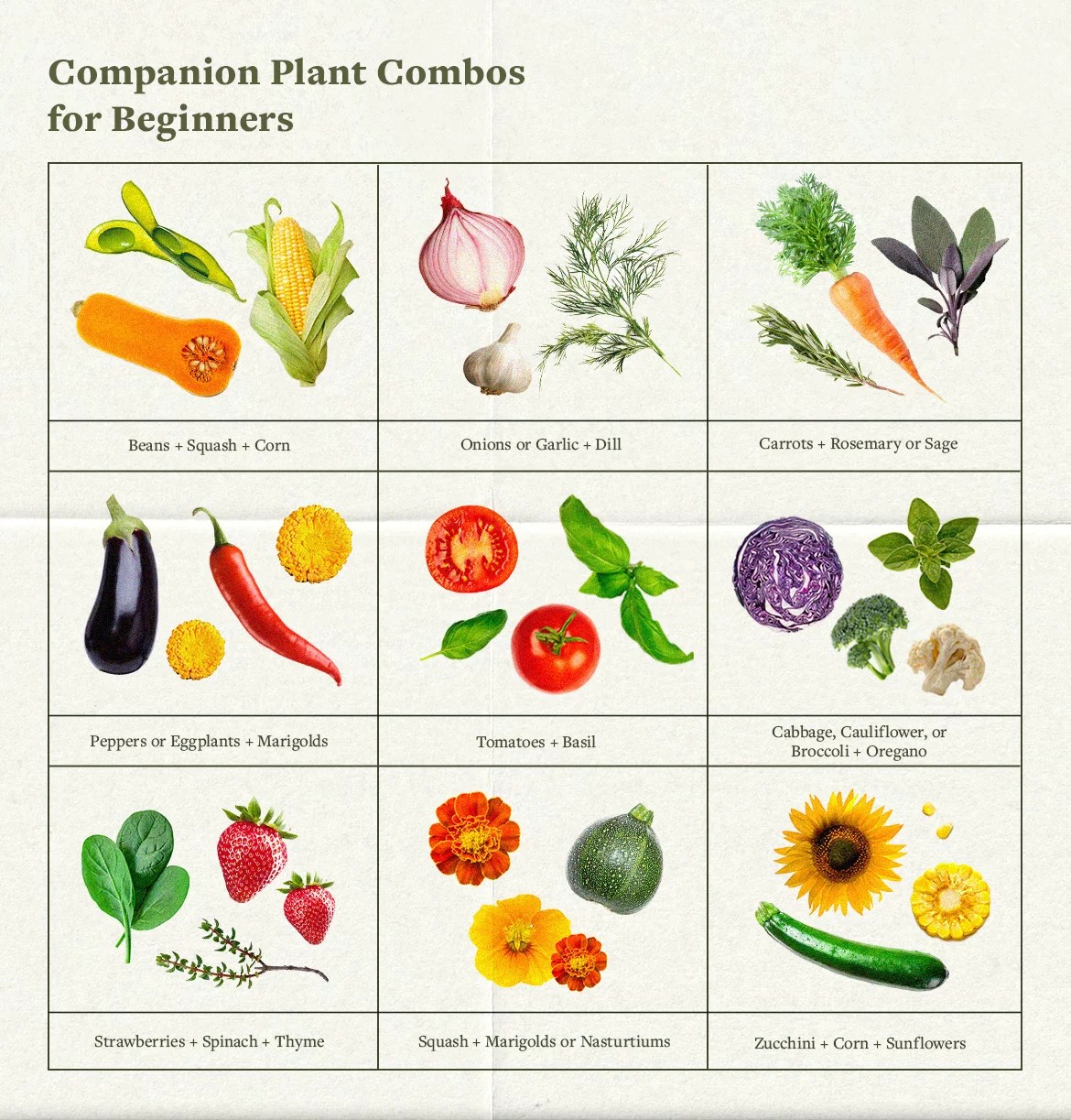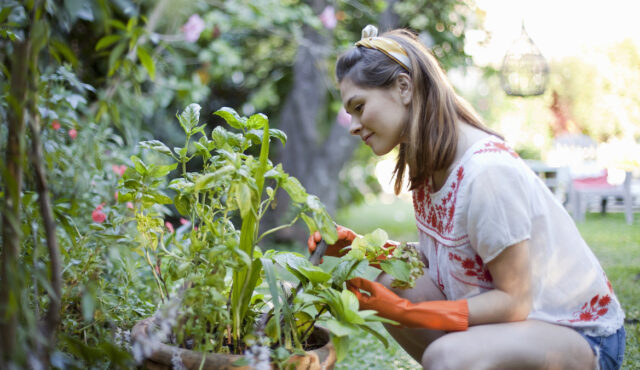It’s a fact of life that certain things are infinitely better when paired together: wine and cheese, peanut butter and jelly, chips and guacamole. But this logic doesn’t apply solely in the kitchen. The idea that certain things work even better together is the entire ethos of companion planting—a gardening technique that’s been employed for hundreds of years to ensure healthier, more successful harvests. And yes, you can do it at home.
Companion planting, also known as intercropping, refers to planting multiple plant species in close proximity to impart both plants with benefits. The tradition has its roots in several cultural traditions from Native American nations, particularly the Iroquois and Cherokee nations, of planting “the three sisters,” or corn, squash, and a climbing bean together. “The idea is that the corn provides some of the initial structural support for the beans, then those two combined provide not only shelter but nitrogen-fixing and nutrients in the soil, then the winter squash is getting some shade and nutrients from those earlier crops while it flourishes in the fall,” explains Scott Oneto, farm advisor at University of California Cooperative Extension. All three plants help each other grow, and in turn create a more bountiful harvest.
“It’s this idea that you’re figuring out what your problem is, and then you’re looking to a companion plant [to solve it].”—Haley O’Connor, formal garden manager at Filoli Historic Estate & Garden
From there, a couple books by gardener Louise Riotte popularized companion planting for the masses, Carrots Love Tomatoes: Secrets of Companion Planting and Successful Gardening (published in 1976) and Roses Love Garlic: Companion Planting and Other Secrets of Flowers (published in 1996), according to Haley O’Connor, formal garden manager at Filoli Historic Estate & Gardens in Woodside, California. “For millennia, people made these amazing observations that when they planted one thing next to another, it either attracted the pest or kept it away from that plant,” she says. “It’s this idea that you’re figuring out what your problem is, and then you’re looking to a companion plant [to solve it].”
The benefits of companion planting
Problem-solving is the ethos of companion planting. The right pairings of companion plants can address a whole host of issues that can plague any garden, say both O’Connor and Oneto. For example, certain plants can attract beneficial insects (such as ladybugs, which eat harmful pests) and pollinators like bees and butterflies. Others can specifically ward off various insect adversaries. “Companion plants also just confuse the bugs because there are more choices,” says O’Connor.
You can also use companion planting to create a structure for trailing plants, to provide shade for other plants, or to shield the floor below with a ground cover. Some combinations might take up ground space and prevent weeds from growing there, while others can create rich and nutritious soil when they decompose that supports strong root systems.
Creating a garden with as much biodiversity as possible—which is what happens with companion planting—helps avoid the issues of a monoculture, which are more prone to be felled by pests and plant illnesses, says Cynthia Nations, PhD, a retired education consultant and a UC Master Gardener in San Mateo/San Francisco Counties in California. Along with crop rotation, or planting crops in different locations year to year as a means to disrupt pests and keep soil healthy, companion planting helps the garden become a place where each plant gets to contribute its strength and have its weaknesses defended. The result? Healthier, happier vegetables and herbs.
In Dr. Nations’ own garden in El Granada, California, she used to just plant tomatoes alone, but she recently started planting basil alongside them and has noticed benefits in terms of their yield, health, and flavor. “I’ve haven’t had any more hornworms, but my tomatoes are just great,” she says.
The basic rules of companion planting
Keep in mind that much of the evidence for which companion planting pairs work is anecdotal; different gardeners are bound to stand by different combinations. But in general, think about pairings that complement one another. Take strawberries and spinach. Spinach’s broad leaves can cover strawberry plants to shade and shelter them from pests, and it contains a compound that makes it fairly pest-resistant.
Avoid combinations of plants that’ll compete for the same resources or suffer from the same issues, such as potatoes and peppers (both belonging to the same plant family, nightshades). Don’t interplant crops that need plenty of space to spread their leaves or grow upward, like broccoli and pole beans, because they’ll stunt each other’s growth.
You also want to avoid using plants that tend to take over wherever they’re planted. For example, mint’s strong aroma makes it a helpful pest deterrent, but Oneto says it tends to take over any garden bed it’s in, which could hinder other plants. An alternative: Plant it in a separate container nearby or in a pot and then bury the pot in your garden bed to contain the roots, he says.
The easiest way to think of what might go well together is to consider what tastes good together, says O’Connor. “Take pico de gallo: if you plant peppers and tomatoes, and onions and garlic all together, you’re going to have a pretty pest-free bed,” she says. Another method? Oneto thinks about the pest most likely to disturb the plant in question, and plants something to directly counter it.
The best starter companion plant combinations

1. Beans + squash + corn
O’Connor calls legumes “the holy grail of companion plants,” because they’re generally resistant to pests and can provide beneficial nitrogen fixing that other plants would benefit from. “Nitrogen helps plants grow so you get these big leafy plants,” she explains. “When you leave [beans] on the ground when they’re dead and mulch with it, it will really improve the soil.” Plant them with the classic Three Sisters pairing of squash and corn—or any other plant that needs shade.
2. Onions or garlic + dill
The allium family (which includes onions, garlic, chives, and leeks) is generally a reliable companion plant for most pest-prone vegetables because of its natural antiseptic properties, says O’Connor. However, these plants tend to be threatened by sucking insects like thrips, says Oneto. “They’re a pretty large order of insects that have an appetite for just about everything,” he says. To contend with these pests, plant dill or parsley. According to Oneto, they “intermix really well with just about anything” because their complex underground root systems are pest resistant and self-sustaining. They also attract various beneficial insects, like ladybugs, which snack on thrips and other pests.
3. Carrots + rosemary or sage
Oneto says carrots are pretty hardy, but are vulnerable to carrot flies—which bore into the heart of carrots and ruin them. Thankfully, fragrant herbs like rosemary and sage can deter those pests with their strong scent.
4. Peppers or eggplants + marigolds
Cousins peppers and eggplants deal with the same pests: worms and lygus bugs. To help them thrive, O’Connor and Oneto recommend marigold. “I’ve seen marigolds and some of the brassicas like arugula used a lot for [nightshades],” he says. Marigold attracts beneficial insects like ladybugs and green lacewings, says Oneto, plus parasitic wasps that eat other pests. (Basil and onions can support these plants, too.)
5. Tomatoes + basil
They don’t only taste great together in caprese salad—tomatoes and basil are perfect companion plants, says O’Connor. The basil’s aroma repels insects that wreak havoc on tomato crops such as thrips and tomato hornworms. This pairing is even thought to improve the flavor of both. (This isn’t backed up by studies, but O’Connor and Dr. Nations say many gardeners report this anecdotally).
6. Cabbage, cauliflower, or broccoli + oregano
If you’ve ever examined a cabbage leaf and found bite holes, you’ve probably seen the work of a cabbage looper, one of this family’s main pests. This cruciferous vegetable family also has issues with beetles and diamondback moths. Aromatic herbs such as oregano, rosemary, and thyme ward off those pets with their fragrance. “Cabbage moths really don’t like nasturtiums, which are also just really big and beautiful,” adds O’Connor.
7. Strawberries + spinach + thyme
Strawberries are a common starter plant for many home gardeners, but unfortunately quite pest-prone; they often suffer from slug, snail, and aphid infestations. Thyme and basil help with this. Beyond pest control, leafy greens like spinach give strawberries shade. O’Connor also likes pairing the fruit with borage, a small star-shaped flower, which attracts helpful pollinators.
8. Squash + marigolds or nasturtiums
O’Connor particularly likes marigolds, geraniums, and nasturtiums as a companion plant for any type of squash (including pumpkins and butternut squash) to combat squash bugs. These flowers also repel root-knot nematodes, aphids, and various beetles and flies—common pests that afflict squashes.
9. Zucchini + corn + sunflowers
Corn works here because of the Three Sisters method, and sunflowers can also provide additional shade to help you grow monster zucchinis. Helpful flowers attract pest-eating insects, and nitrogen-fixers like peas and beans make the soil especially nourishing.
3 tips for home gardeners to start companion planting
1. Start small
You don’t need to have a sprawling garden plot to make companion planting work. Dr. Nations recommends starting small with just a couple companion pairs in a bed or container, like tomato and basil, to see how it goes. Don’t worry too much about starting off a bunch of plants, because then it’ll get too complicated and you might get discouraged.
2. Keep notes about your progress and growth rates
One of the best ways to track your progress in your garden is to actively take notes on what’s working and what’s not. Dr. Nations uses an in-depth spreadsheet, but keeping a running note on your phone or in a pad of paper to track when you planted certain seeds and which combinations seem to be working and not is all you need. “You have to experiment and adapt, and it involves a learning curve,” she says. If you suddenly notice your strawberries growing plumper, it’s helpful to be able to go back and see if planting it alongside dill could be to thank.
3. Start with a strong soil base
Soil is incredibly important to get plants all the nutrients they need to grow large and luscious. Start with high quality soil or potting mix, and add compost. Dr. Nations tried mixing organic cow manure into the soil that sprung her prized tomatoes this year, but you could ask your local garden center for tips for what works best in your grow zone (consult the USDA Plant Hardiness Zone Map for the ideas of what and when to plant where you live).
- Ali, Ahmad, et al. “Garlic Substrate Induces Cucumber Growth Development and Decreases Fusarium Wilt through Regulation of Soil Microbial Community Structure and Diversity in Replanted Disturbed Soil.” International Journal of Molecular Sciences, 2020, https://doi.org/10.3390%2Fijms21176008. Accessed 30 Aug. 2023.
Our editors independently select these products. Making a purchase through our links may earn Well+Good a commission.









